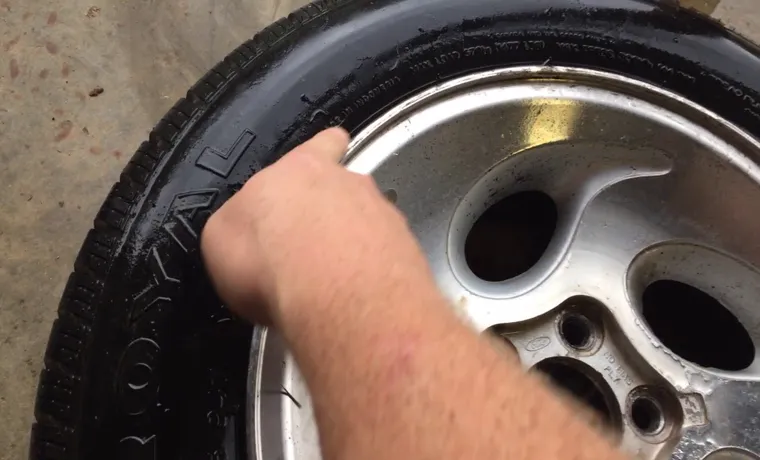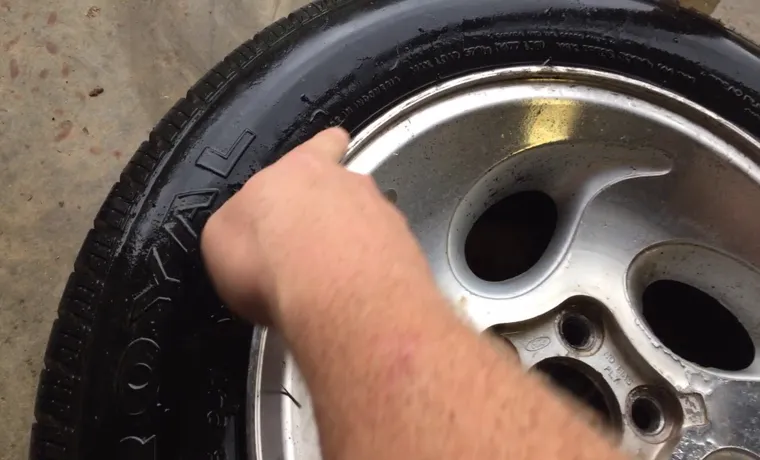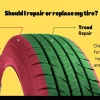Have you ever heard of a tire bead leak? This is a common issue that can occur in your vehicle’s tires and can cause significant problems if left unchecked. Essentially, a tire bead leak is when the seal between the tire bead and your wheel is damaged or compromised, leading to air leaking out of the tire. This can cause your tire to lose pressure quickly, which can lead to blowouts or other dangerous situations.
Think of it like a leaky faucet – if you don’t fix it, it’s only going to get worse. In this blog post, we’ll dive deeper into what exactly causes a tire bead leak, how to spot the signs of a leak, and what you can do to fix it. So, let’s get started!
Table of Contents
The Basics of Tire Bead
If you’re experiencing issues with your tires holding air pressure, it could be due to a tire bead leak. The bead of a tire refers to the inner edge of the tire that sits on the wheel rim. The bead creates a seal between the tire’s inner liner and the wheel rim to hold the tire’s air pressure.
A tire bead leak occurs when that seal is compromised, which can be caused by several factors, including wear and tear, corrosion, or damage to the bead. Symptoms of a tire bead leak can include a loss of air pressure, hissing sounds coming from the tire, or even a visible separation between the tire and the wheel rim. If you suspect a tire bead leak, it’s important to have it repaired or replaced to ensure your safety while driving.
What is a tire bead?
A tire bead plays a vital role in maintaining the stability and performance of a tire. It’s often an overlooked part of a tire, but it’s responsible for keeping the tire firmly seated on the wheel. A tire bead consists of a steel cable coated in rubber that runs around the inner circumference of the tire.
It has a unique shape designed to fit snugly into the tire rim and prevent it from slipping off. The bead is held in place by tensile force created when the tire is inflated. A properly seated bead ensures the tire offers optimal grip, handling resistance, and stability.
If a tire bead is damaged or breaks, it can compromise the safety and performance of a tire. In summary, a tire bead is a crucial component that maintains the integrity of a tire and provides safety benefits to drivers and passengers on the road.

How does a tire bead work?
Tire bead is an essential component of a tire, but not many people know what it is or how it works. At its most basic, a bead is the part of the tire that fits tightly against the rim of the wheel. It is made up of high-strength steel cables that are coated in rubber, which is what creates the tight seal.
The bead’s purpose is to hold the tire onto the rim, so it doesn’t slip or come loose. It also helps to maintain the tire’s shape and stability, and it plays a critical role in ensuring a smooth ride, especially when driving at high speeds. In summary, the tire bead is a small but mighty component of a tire that should never be overlooked.
What are the possible causes of bead leaks?
When it comes to tire maintenance, one common issue that drivers may encounter is a bead leak. The tire bead is the part of the tire that seals against the rim, ensuring that the tire stays securely in place while driving. If there is a leak in the bead, air can escape from the tire, leading to deflation and potentially dangerous situations on the road.
There are several possible causes of a bead leak, including corrosion on the wheel rim, damage to the tire bead itself, or improperly installed tires. Some signs of a bead leak include a hissing sound coming from the tire, a noticeable loss of air pressure, or vibration while driving. It’s important to address any bead leaks as soon as possible to ensure safe driving conditions.
Regular tire inspections and proper installation can help prevent bead leaks from occurring in the first place, keeping you and your vehicle safe on the road.
Symptoms of a Tire Bead Leak
When it comes to tire maintenance, one common issue that drivers may encounter is a tire bead leak. This occurs when the tire bead, which is the part of the tire that seals against the rim, is not properly seated against the rim or has developed damage. Symptoms of a tire bead leak can include a noticeable drop in tire pressure, vibration while driving, and even a popping or hissing sound.
In severe cases, the tire may even come completely off the rim while driving, which is obviously quite dangerous. If you notice any of these symptoms, it’s important to have your tires inspected as soon as possible by a qualified mechanic. Tire bead leaks can usually be fixed by simply re-seating the tire bead or replacing the damaged tire, but it’s important not to ignore the issue as it can worsen with time and use.
So next time you check your tire pressure, be sure to keep an eye out for any signs of a bead leak and address the issue promptly to ensure your safety on the road.
How to detect a bead leak?
If you suspect that your tire is losing air, then you may be dealing with a tire bead leak. The tire bead is what forms the seal between the tire and the rim, keeping the air inside the tire. When the tire bead becomes damaged or worn, air can escape from the tire causing it to go flat.
If you notice that your tire is losing air slowly over time, then it could be a sign of a bead leak. Other common symptoms of a tire bead leak include difficulty maintaining tire pressure, a hissing sound coming from the tire while driving, or uneven tire wear. If you experience any of these symptoms, it’s important to have your tire inspected by a professional.
Getting a tire bead leak fixed early can prevent further damage and keep you safe on the road.
What are the signs of a bead leak?
If you suspect that your vehicle’s tire is losing air and you’ve already checked for punctures, then a bead leak may be the culprit. A tire bead leak occurs when the seal between the tire and the wheel is compromised, causing air to escape. The signs of a bead leak are relatively easy to spot.
You may notice that your tire doesn’t hold air pressure for as long as it should, or it seems to lose air completely overnight. The tire may also appear to bulge out or deform from the wheel, indicating that the seal is no longer tight. Additionally, you may hear a hissing sound coming from the tire when it’s inflated, indicating that air is escaping through the bead leak.
It’s essential to get the tire repaired or replaced as soon as possible, as driving on a tire with a bead leak can be dangerous.
Effects of a Tire Bead Leak
A tire bead leak occurs when the tire’s bead, which is the part of the tire that sits against the rim, is damaged. This can cause air to leak out, leading to low tire pressure and potentially dangerous driving conditions. In addition to decreased tire performance and the risk of a blowout, a tire bead leak can also negatively impact fuel economy and, if left unaddressed, cause damage to the wheel or suspension components.
If you notice any signs of a bead leak, such as hissing sounds or uneven tire wear, it’s important to have your tire inspected and repaired by a professional as soon as possible to ensure your safety on the road. Regular tire maintenance can also help prevent bead leaks from occurring in the first place, such as checking tire pressure and ensuring proper alignment and balance.
What are the dangers of driving with a bead leak?
A tire bead leak can be a dangerous issue that can lead to a number of negative effects on the performance of the vehicle. It occurs when the seal between the tire and wheel breaks, causing air to escape from the space between the two. This can lead to decreased tire pressure, which can cause the tire to wear unevenly, reducing its lifespan and causing it to burst while driving.
Driving with a tire bead leak can also cause vibrations in the vehicle, which can make it difficult to steer or control, especially at high speeds. In addition, a lack of air pressure can cause the tire to overheat and become damaged, increasing the risk of a blowout. To ensure your safety and prolong the life of your vehicle’s tires, it’s important to have any tire bead leaks repaired as soon as possible.
How does a bead leak affect your tires and car?
A tire bead leak can cause significant repercussions, affecting both your tires and car. When the bead – the part of the tire that sits securely on the wheel’s rim – leaks, air escapes from the tire, causing it to deflate. Such problems lead to unequal tire wear, compromising your car’s stability, traction, and performance.
A flat tire also places a substantial burden on different components of your vehicle, including the suspension, steering system, and brakes. These systems are engineered to work together, meaning that affecting one negatively could affect the others. Moreover, driving on a flat tire can cause damage to the rim, causing it to dent, leading to expensive repairs.
It’s essential to keep your vehicle’s tires properly inflated to avoid potential risks associated with bead leaks. Consider investing in a tire pressure gauge to help you check your tires’ pressure regularly. Additionally, inspect your tires periodically for any signs of damage, including bead leaks, and have them repaired or replaced urgently when you notice any problems.
Remember, your tires are the only point of contact between your car and the road. Therefore, ensuring that they are in excellent condition is essential for your safety and car’s longevity.
What to Do When You Have a Tire Bead Leak?
Have you ever experienced your car tire losing air quickly and wondering what to do? Well, the culprit could be a tire bead leak. A tire bead leak is when the seal between the tire bead and the rim breaks, causing air to escape. There are a few things you can do in this situation.
Firstly, check the tire pressure and inspect the tire for any visible damage. If the tire is still in good condition, you can try reseating the tire bead by removing the tire and lubricating the bead and rim with bead sealant. Alternatively, you can take the tire to a professional who can fix the bead seal or replace the tire if necessary.
Remember to always take care of your tires to avoid any unexpected issues like a tire bead leak. Proper maintenance can go a long way in keeping your car safe and running smoothly.
Conclusion
In summary, a tire bead leak is like a tiny defector in the tire world, causing trouble and drama for all parties involved. It’s the underdog of tire issues, often going unnoticed until it causes noticeable damage. But fear not, with proper maintenance and attention to the tiniest details, we can all band together and prevent these pesky little leaks from ruining our road trip vibes.
“
FAQs
What causes a tire bead leak?
A tire bead leak is caused by a gap between the tire bead and the wheel rim, which can result from damage or wear to the wheel or tire.
How can you detect a tire bead leak?
Signs of a tire bead leak can include a hissing sound from the tire, reduced tire pressure, or difficulty maintaining proper inflation levels.
Can a tire bead leak be repaired?
It is possible to repair a tire bead leak, depending on the extent of the damage and the tire’s condition. However, replacing the tire may be recommended in some cases.
How do you prevent tire bead leaks?
Regular tire maintenance, including proper inflation levels and removing debris from the tire and wheel surfaces, can help prevent tire bead leaks.
What are the risks associated with driving on a tire with a bead leak?
Driving on a tire with a bead leak can result in reduced handling and stability, uneven tire wear, and potential tire failure.
Can a tire bead leak cause a flat tire?
Yes, a tire bead leak can cause a flat tire if it is not addressed promptly. The reduced tire pressure can cause the tire to go flat or blow out.
How much does it cost to repair or replace a tire with a bead leak?
The cost of repairing or replacing a tire with a bead leak can vary depending on the severity of the damage and the type of tire and wheel. It is best to consult a professional for an accurate estimate.



